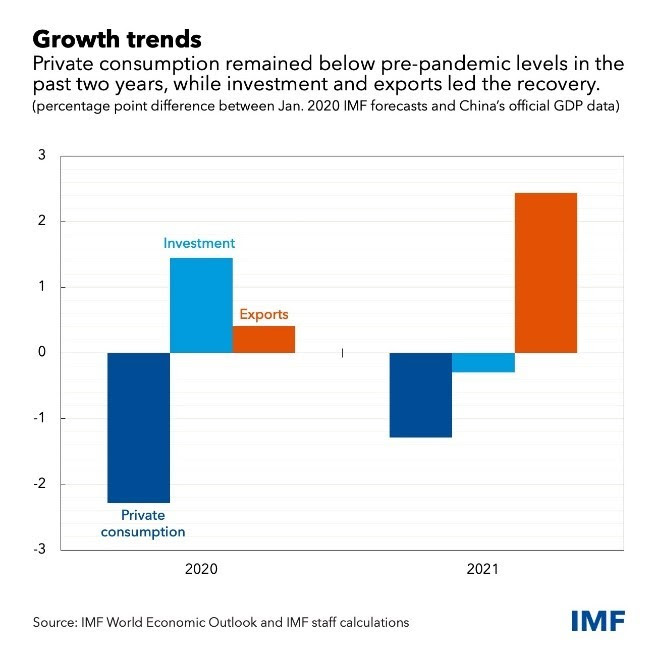China’s shift to consumption-led growth can aid green goals

By Chang Yong Rhee, Helge Berger and Wenjie Chen IMF Asia and Pacific Department
China rebounded strongly from the pandemic, but growth is losing momentum while remaining overly dependent on support from investment and exports. This imperils the nation’s long-sought transition to sustained high-quality growth that’s balanced, inclusive and green.
While China’s many challenges have no easy answer, the key message of the IMF’s annual Article IV review of the economy is that rebalancing toward a more consumption-based model will boost growth prospects in the short term and deliver high-quality expansion in the long run. Importantly, it will also help bring the country closer to achieving its climate goal of carbon neutrality before 2060.
More immediate economic headwinds include slowing real estate investment and rapid withdrawal of fiscal support. What’s more, new outbreaks of more transmissible virus variants are prompting more lockdowns, weighing on the crucial recovery of private consumption.
While exports have boosted growth during the pandemic, these global tailwinds are poised to unwind eventually, leaving the world’s second-largest economy to contend with serious challenges. One of these is stagnant domestic productivity growth, which has leveled off in the past 10 years just as China’s workforce stopped expanding.
See more: Apple grabs record China market share as Q4 sales surge-research
Economic challenges
Obstacles also include waning benefits from traditional infrastructure spending and technological decoupling, the reduced flow of international trade in high-tech goods and services. Importantly, a slowdown in trade and cross-border investment is bound to be quite costly economically and can affect global growth, recent IMF staff research shows.
And China’s quest for carbon neutrality is another challenge to tackle.
So, what are policymakers to do? The country will benefit in the long run from a strategy that strengthens consumption in a more lasting way while also supporting greater productivity. And a shift to a more consumption-based growth model will also get China closer to its climate goals.
In the near term, fiscal policy should be more neutral and steer spending away from infrastructure and toward income support to vulnerable people to boost lagging private consumption. And an improved social protection system would offer people more security, reduce precautionary savings, and better promote consumption in the future.
Fostering competition
At the same time, re-energizing economic reforms stalled by the pandemic would boost productivity and reverse faltering market dynamism by empowering private enterprises. This means letting private firms compete more with state-owned companies and continuing to open domestic markets.
Rebalancing China’s growth promises a double benefit, supporting the domestic economy while also improving prospects for the world avoiding the worst effects of climate change.
Further investment-driven growth would not only accelerate the decline in investment returns but also, —due to the high carbon-intensity of investment, including from construction—make it much harder for China to meet its climate goals.
Conversely, successfully rebalancing toward consumption will aid China’s climate aims by shifting activity to relatively untapped services industries and away from carbon-intensive industrial sectors.
Of course, there will be tradeoffs between achieving climate goals and growth. While those cannot be fully eliminated, rebalancing towards more consumption-led growth will decrease the energy intensity of China’s GDP and thus, lessen the country’s energy demand and ease the pressure for energy security. In fact, rebalancing alone can help cut carbon emissions by about 15 percent over the next three decades, as IMF staff simulations show. At the same time, climate policies combined with greener investment—which is more productive and growth-friendly than traditional spending—will help steer demand away from emissions-intensive uses and support greener development.
See more: Chinese laboratory hails 6G breakthrough with record speed test
Together, policies centered around economic rebalancing would ensure that sustained high-quality growth is achievable and more durable. This would not only benefit China, but also the world.









